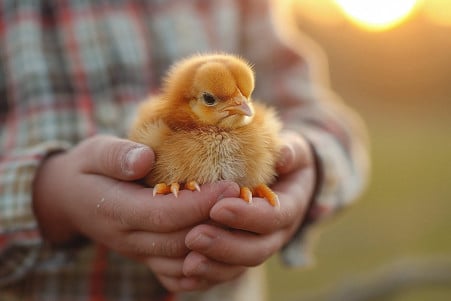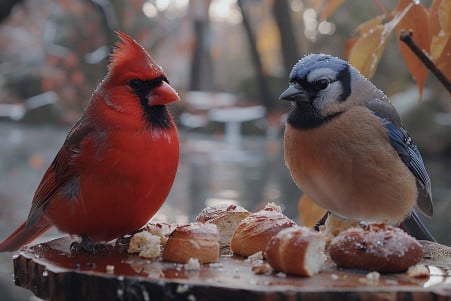How to Feed a Baby Bird: Expert Advice on the Right Diet
8 May 2024 • Updated 7 May 2024

Feeding a baby bird can be a tricky business, especially if you don't know what the bird's specific dietary needs are or how to feed it. Most baby birds will need a diet that includes a combination of high-protein foods like mashed bugs or wet dog/cat food and some ground seeds, fruit, and puppy milk replacement formula for hydration. You will also need to feed the bird every 20 minutes while it's awake.
It can be overwhelming to figure out how to do all of this, but we're here to help you understand the science-based ways to feed baby birds safely and effectively. By working with wildlife rehabilitators and looking at the science of birds, we will cover the best feeding schedules for different species and developmental stages. By the end, you'll feel comfortable knowing that you can keep these delicate birds alive until they're ready to be released or taken to a professional.
What is the proper way to feed a baby bird?
How to Help a Baby Bird: When to Step In and When to Let Nature Be
When you come across a baby bird, it’s important to know the difference between nestlings and fledglings because their needs are so different. Nestlings are born featherless or with minimal down and their eyes are closed at first, while fledglings are fully feathered but can’t yet fly. If you find a nestling on the ground or in a nest that appears to have been abandoned, it’s time to step in because nestlings can’t survive on their own at this stage.
On the other hand, fledglings that are hopping around on the ground are part of the normal process of learning to fly and are still being cared for by their parents. If you rescue a fledgling that doesn’t need help, you could end up doing more harm than good by separating it from its parents and disrupting its natural development.
That said, if a fledgling is showing signs of injury or illness, such as wet feathers, an inability to hop or walk, or the presence of flies, which can indicate an open wound, it may need professional help. In the case of adult birds, if you see signs of distress, such as drooping wings, difficulty perching or breathing, or the inability to fly away when you approach, you should also consider intervening.
In all of these cases, it’s important to take a step back and observe the bird from a distance before you do anything. This will help you avoid accidentally separating the baby bird from its parents. In general, it’s best to take a wait-and-see approach to determine whether the bird truly needs help or if it’s best to leave it where it is with its parents watching over it. If you’re not sure, it’s best to get advice from a wildlife rehabilitation professional to make sure you’re doing the right thing for the bird.
Temporary Care: How to Set Up a Safe Space for Rescued Baby Birds
The less interaction and handling the bird receives, the better. According to the Toronto Wildlife Centre, the baby bird should be placed in a dark, quiet indoor space, like a cardboard box or other enclosed space with ventilation.
The bird will also need a heat source to help regulate its body temperature, like a rice sock or warm water bottle. This will help the bird relax, as the Best Friends Animal Society explains, and will help prevent additional stress on the bird's system. However, it's important not to try to feed or water the bird, as this can cause the bird to aspirate and lead to issues like pneumonia or drowning.
It's important to reiterate the importance of getting the bird to a licensed wildlife rehabilitator as soon as possible. As the Greenwood Wildlife Rehabilitation Center points out, if the mother doesn't return to the baby bird, it's important to get in touch with a wildlife rehabilitation expert to ensure the bird is getting the care it needs.
Safe Foods and Feeding Techniques for Orphaned or Injured Baby Birds
While professional help is the best way to ensure the best care for orphaned or injured baby birds, there are some safe options for food and feeding that can be used in the interim before the bird can be taken to a wildlife rehabilitation center.
The Ultimate Guide lists safe options for baby birds that can be used in the short term, including mashed insects like worms or grasshoppers, wet dog or cat food, crushed seeds, and specialized baby bird formula supplements. These high-protein options can help ensure that the baby bird gets the nutrition it needs while it waits for professional care. Wildlife Watch suggests using a small plastic syringe to feed the baby bird, being sure to feed it slowly and allowing time for the food to be swallowed before giving it more. They also note that frequent feedings every 20-30 minutes are important when the baby bird is alert and awake.
It's important to avoid feeding the baby bird common human foods like bread or raw meat, as these can be dangerous for the baby bird's delicate system. As Birds and Blooms notes, while a baby bird may seem to do well on these foods in the short term, they won't provide the nutrition the baby bird needs for long-term health and well-being. However, it's still best to consult with licensed wildlife rehabilitators to ensure that the baby bird is getting the right care and diet for its species and stage of development.
Seeking Professional Help: The Importance of Wildlife Rehabilitation Centers
Licensed wildlife rehabilitation centers have the knowledge and facilities necessary to provide the care and support that orphaned or injured baby birds need to survive and be released back into the wild. According to VCA Animal Hospitals, these centers have the appropriate housing, staff, and diets that are specific to different bird species.
PetMD also notes that in many states, it is illegal for people to care for orphaned wild birds without the proper permits and training. In addition to the legal ramifications, attempting to care for these animals without the necessary knowledge and experience can be life-threatening for the birds, as they may not get the care they need to survive.
On the other hand, wildlife rehabilitation centers are essential to ensuring that these birds have the best chance of surviving and thriving when they are eventually released back into the wild. According to PETA, it is important to contact a licensed rehabilitator right away, as they are equipped to provide the specialized care that these birds need.
When you seek professional help, you can rest assured that the orphaned or injured baby birds will get the care, medical attention, and gradual release back into the wild that will help them have the best chance of survival. This is important for the well-being of these birds and the health of the local ecosystems.
Avoiding Unnecessary Interventions: Understanding Baby Bird Growth and Behavior
Understanding the natural growth and behavior of baby birds is important to avoid unnecessary interventions that may hurt the bird more than help it. Per Audubon, the most important distinction is between nestlings - birds that are either featherless or have just a few feathers and are still in the nest - and fledglings, which are fully-feathered young birds that have left the nest but are still being cared for by their parents.
Nestlings that are found on the ground or with an abandoned nest need to be rescued immediately, but fledglings that are hopping around are actually in a normal stage of development, where they are learning to fly while their parents still care for them in the wild. In fact, rescuing healthy fledglings can be harmful to them, as it will separate them from their parents and disrupt their natural development.
The Lake Metroparks notes that it's important to watch from a distance before intervening, as many birds that are on the ground are not in danger and just need time to learn to fly. It's important to understand and honor these natural processes to avoid unnecessary and potentially harmful interventions.
Conclusion: How to Help Baby Birds Survive
The most important thing to remember when you come across a baby bird is to approach the situation with care, knowledge, and an understanding of the natural processes that are at work. By learning how to tell the difference between nestlings and fledglings, creating safe temporary environments, and working with professionals when it's necessary, we can help baby birds survive and thrive.
In the end, the most important things we can do are to watch from a distance, avoid unnecessary interventions, and appreciate the important role that licensed wildlife rehabilitation centers play in providing the specialized care that baby birds need. Only by following these guidelines can we help ensure the survival of our local bird populations and the ecosystems that they are a part of. By doing this, we can also deepen our connection to the natural world and help ensure the survival of these amazing animals.


